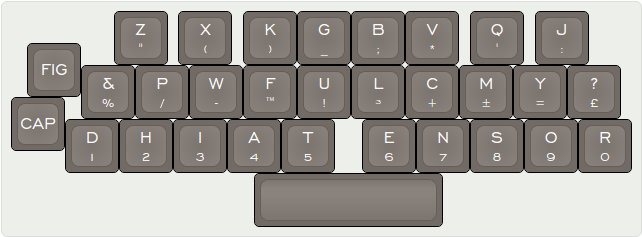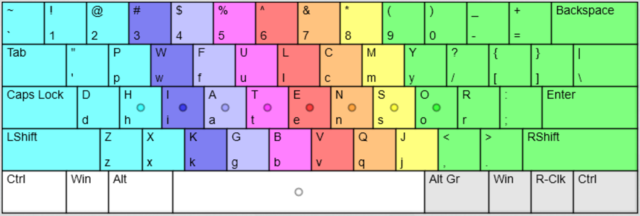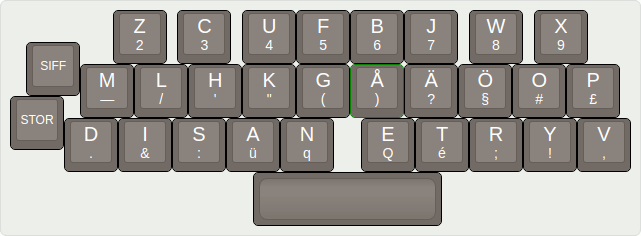DHIATENSOR
 | |
| Creator | George C. Blickensderfer |
|---|---|
| Introduced |
1893 (Typewriter) 2005? (ANSI) |
'PWFU LCMY/ | |
DHIAT ENSOR | |
ZXKGB VQJ,. | |
Contents
Description
DHIATENSOR, also known as the Blickensderfer Scientific Key-Board layout by its creator was one of the two keyboard layouts available for the Blickensderfer typewriter, designed by George Canfield Blickensderfer in 1892. (The other typewriter layout was QWERTY, called "Universal"). The moniker "DHIATENSOR" refers to the keys of the home row from left to right.
The typewriter keyboard has three rows and a symmetric stagger. The "home row" is the bottom row, where also figures (digits) are available on its own layer through the "FIG" modifier. The FIG and CAP modifiers can not be used together.
The layout had been based on a study of the English language that had showed that 70% written text and about 85% of all words used the letters D,H,I,A,T,E,N,S,O and R. The middle row contains letters that occur 24% (13%) of the time and the top row in about 6% (2%) of all text (words).[1]
Variations
Original
Different variations of the layout exist with different figures.
On a standard keyboard
When mapped onto a staggered typewriter keyboard where the home row is in the middle, the rows are rotated upwards a step, to align the "DHIATENSOR" home row with the home row. The top row is moved to the bottom.
Swedish
Swedish Blickenserfer typewriter are supposedly similarly based on statistics for Swedish. The Swedish alphabet has three more letters than English so the unusual letter Q has been moved to the numeric layer. Glyphs for é and ü were present on many typewriters and (non-IBM PC) computer keyboards for Swedish well into the 1990s. Note that the digits have moved to the top row and lack the digits 1 and 0, as on many QWERTY keyboards.
Trivia
The electric version of the Blickensderfer typewriter (of which many but not all have the DHIATENSOR layout) was one of the very first electric typewriters and it was the first with a proper Carriage Return key. The key was however named "Left", or simply "L", but it was located in about the same position as an ISO Return key today but not as far right.
The Blickensderfer Electric failed in the marketplace however because at the time it was difficult to use electricity for anything but lighting: outlets, voltage and AC frequency had not been standardised and some electrical companies even turned it off during daylight hours. Only about 1500 typewriters were made, and sold mostly to customers who had preordered it. Now, they are some of the most rare and desirable among typewriter collectors.
Decades later, IBM copied the location of the Return key, and even later a similar typing mechanism for its Selectric typewriter.
References
- ↑ ozTypewriter: IBM Selectric Typewriter with Blick Keyboard!. Dated 2012-02-22. Retrieved 2017-08-19.


